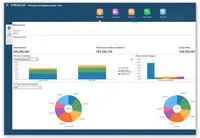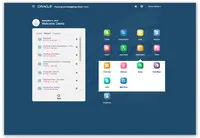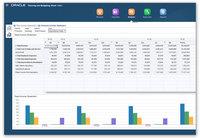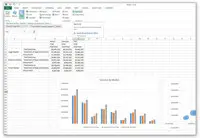Oracle Fusion Cloud Enterprise Performance Management
Overview
What is Oracle Fusion Cloud Enterprise Performance Management?
Oracle Fusion Cloud Enterprise Performance Management (EPM) is a solution that helps users model and plan across finance, HR, supply chain, and sales, streamline the financial close process. Oracle Cloud Enterprise Performance Management (EPM) Platform is a framework of the…
Oracle EPM does the job for consolidation, planning, and analytical reporting to gain insights into your business
Oracle EPM cloud helps aligns with Business Strategy execution and to make data-Informed decisions faster
Oracle Cloud EPM - Next Big Thing
Oracle EPM Cloud is like a crystal ball for your organization
Oracle Cloud EPM--the future of EPM
Great if you don't have access to on-premises licensing
EPM Cloud and My Views
Great if you don't have on-prem licensing
Efficient EPM platform for all companies.
Oracle Planning & Budgeting Enables Unicorn to Scale!
EPM Cloud
Planning and budgeting at your fingertips!
Oracle EPM Cloud Review
Oracle Financial Consolidation and Close Cloud - Why use it?
Awards
Products that are considered exceptional by their customers based on a variety of criteria win TrustRadius awards. Learn more about the types of TrustRadius awards to make the best purchase decision. More about TrustRadius Awards
Popular Features
- Financial budgeting (38)9.797%
- Flat file integration (34)9.696%
- Forecasting (37)8.989%
- Scenario modeling (35)8.686%
Pricing
EPM Standard
$250
EPM Enterprise
$500
Entry-level set up fee?
- No setup fee
Offerings
- Free Trial
- Free/Freemium Version
- Premium Consulting/Integration Services
Product Demos
Accelerating User Adoption of Oracle Cloud EPM with James Rodgers | EPMIcast Episode 16
Features
BI Standard Reporting
Standard reporting means pre-built or canned reports available to users without having to create them.
- 8.1Pixel Perfect reports(2) Ratings
Pixel Perfect reports are highly-formatted reports with graphics and ability to preview the report before printing.
- 4.4Customizable dashboards(3) Ratings
Customizable dashboards are dashboards providing the builder some degree of control over the look and feel and display options.
- 4.4Report Formatting Templates(3) Ratings
Ad-hoc Reporting
Ad-Hoc Reports are reports built by the user to meet highly specific requirements.
- 9.7Drill-down analysis(22) Ratings
Drill down analysis is the ability to get to a further level of detail by going deeper into the hierarchy.
- 9.5Formatting capabilities(21) Ratings
Ability to format output e.g. conditional formatting, lines, headers, footers.
- 8.4Report sharing and collaboration(19) Ratings
Report sharing and collaboration is the ability to easily share reports with others.
Report Output and Scheduling
Ability to schedule and manager report output.
- 9Publish to Web(16) Ratings
- 8.9Publish to PDF(19) Ratings
- 9Report Versioning(17) Ratings
Report versioning is the assignment of version numbers to each version of a report to help in tracking.
- 9Report Delivery Scheduling(15) Ratings
Report Delivery Schedule is the ability to have reports delivered to a destination at a specific data and time.
Data Discovery and Visualization
Data Discovery and Visualization is the analysis of multiple data sources in a search for patterns and outliers and the ability to represent the data visually.
- 6Pre-built visualization formats (heatmaps, scatter plots etc.)(3) Ratings
Pre-built visualization formats are canned visualization types that can be selected to visualize different kinds of data.
- 6.8Location Analytics / Geographic Visualization(3) Ratings
Location analytics is the visualization of geographical or spatial data.
- 5.1Predictive Analytics(3) Ratings
Predictive Analytics is the ability to build forecasting models based on existing data sets.
Access Control and Security
Access control means being able to determine who has access to which data.
- 9Multi-User Support (named login)(20) Ratings
Named model access means that users have access based on name and password.
- 9.3Role-Based Security Model(23) Ratings
Role-based access means that access to data is determined by job or position in the corporation.
- 8.9Multiple Access Permission Levels (Create, Read, Delete)(20) Ratings
Multiple access permission levels means that different levels of users have different rights.
- 9.3Single Sign-On (SSO)(21) Ratings
Allows users to use one set of login credentials to access multiple applications
Mobile Capabilities
Support for mobile devices like smartphones and tablets.
- 6.2Responsive Design for Web Access(2) Ratings
Web design aimed at producing easy-to-read sites across a range of different devices.
Budgeting, Planning, and Forecasting
These activities are designed to assist with both data-driven operational, short-term planning and strategic long term planning
- 9.2Long-term financial planning(30) Ratings
3-5 year financial plan with cashflow.
- 9.7Financial budgeting(38) Ratings
Annual budget for revenue and operating expenses, headcount/compensation, capital expenses, projects, etc.
- 8.9Forecasting(37) Ratings
Combining actuals and budgets, rolling forecasts, driver-based models.
- 8.6Scenario modeling(35) Ratings
Financial or operational modeling of alternate future states and planning for each.
- 7.8Management reporting(33) Ratings
Budget vs. actual or forecast, P&L’s, performance over time, between products etc.
Consolidation and Close
Consolidation of data from multiple entities with currency management, reporting and audit trails.
- 9.8Financial data consolidation(17) Ratings
Consolidating data from several entities into a single statement using US GAAP, IFRS or other standards.
- 9.7Journal entries and reports(14) Ratings
Ability to enter journal entry adjustments and produce reports showing all journal entries for a specific period.
- 8.9Multi-currency management(13) Ratings
Ability to handle foreign currency conversions during consolidation.
- 8.9Intercompany Eliminations(14) Ratings
Matching and elimination of intercompany revenue, expenses, and balance sheet accounts.
- 8.6Minority Ownership(12) Ratings
Consolidate financials full or partial ownership of subsidiaries, equity pick-up.
- 9.7Local and consolidated reporting(16) Ratings
Ability to report against individual business entities and the consolidated umbrella entity.
- 8.2Detailed Audit Trails(16) Ratings
Tracing changes to data and processes that were run.
Financial Reporting and Compliance
Financial statements and regulatory filings
- 9.6Financial Statement Reporting(29) Ratings
Creation and production of balance sheets, income statements, cash flows, other schedules
- 7.9Management Reporting(32) Ratings
Tools facilitating creation of internal ad hoc or standard reports.
- 8.4Excel-based Reporting(30) Ratings
Ad hoc or formatted reports using MS Excel.
- 7.8Automated board and financial reporting(28) Ratings
Tools to help automate creation of regulatory reports such as SEC filings and board books.
- 8.5XBRL support for regulatory filing(19) Ratings
Support for the XBRL standard reporting format for exchanging financial data.
Analytics and Reporting
Dashboards and scorecards for KPI monitoring and benchmarking
- 8.2Personalized dashboards(25) Ratings
Create custom dashboards and reports without the help of IT or administrators.
- 7.7Color-coded scorecards(3) Ratings
Track and analyze performances with interactive, color-coded balanced scorecards.
- 7.4KPIs(4) Ratings
Select from a library of more than 6,000 key performance indicators, and incorporate KPIs into your planning process.
- 6.7Cost and profitability analysis(4) Ratings
Cost and profitability analysis provides data for business decision making.
- 8.1Key Performance Indicator setting(24) Ratings
Ability to set key performance indicators for measuring progress towards goals.
- 8Benchmarking with external data(24) Ratings
CPI, daily exchange rates, industry KPIs. with scheduled data refreshes.
Integration
Ability to integrate with external applications.
- 9.6Flat file integration(34) Ratings
Integration of flat files like text documents and comma separated files
- 9.6Excel data integration(32) Ratings
Ability to integrate directly with Excel data.
- 8.2Direct links to 3rd-party data sources(28) Ratings
Integration with external applications like ERP, CRM, HCM
Product Details
- About
- Competitors
- Tech Details
- Downloadables
- FAQs
What is Oracle Fusion Cloud Enterprise Performance Management?
Oracle Fusion Cloud Enterprise Performance Management Features
Budgeting, Planning, and Forecasting Features
- Supported: Long-term financial planning
- Supported: Financial budgeting
- Supported: Forecasting
- Supported: Scenario modeling
- Supported: Management reporting
Consolidation and Close Features
- Supported: Financial data consolidation
- Supported: Journal entries and reports
- Supported: Multi-currency management
- Supported: Intercompany Eliminations
- Supported: Minority Ownership
- Supported: Local and consolidated reporting
- Supported: Detailed Audit Trails
Financial Reporting and Compliance Features
- Supported: Financial Statement Reporting
- Supported: Management Reporting
- Supported: Excel-based Reporting
- Supported: Automated board and financial reporting
- Supported: XBRL support for regulatory filing
Analytics and Reporting Features
- Supported: Personalized dashboards
- Supported: Key Performance Indicator setting
- Supported: Benchmarking with external data
Integration Features
- Supported: Flat file integration
- Supported: Excel data integration
- Supported: Direct links to 3rd-party data sources
Ad-hoc Reporting Features
- Supported: Drill-down analysis
- Supported: Formatting capabilities
- Supported: Report sharing and collaboration
Report Output and Scheduling Features
- Supported: Publish to Web
- Supported: Publish to PDF
- Supported: Report Versioning
- Supported: Report Delivery Scheduling
Access Control and Security Features
- Supported: Multi-User Support (named login)
- Supported: Role-Based Security Model
- Supported: Multiple Access Permission Levels (Create, Read, Delete)
- Supported: Report-Level Access Control
- Supported: Table-Level Access Control (BI-layer)
- Supported: Field-Level Access Control (BI-layer)
- Supported: Single Sign-On (SSO)
Additional Features
- Supported: Embedded Financial Intelligence
- Supported: Prebuilt Workforce Planning Business Process
- Supported: Prebuilt Capex Planning Business Process
- Supported: Prebuilt Project Financial Planning Business Process
- Supported: Prebuilt Financial Statement Planning Business Process
- Supported: Multi Device Access
- Supported: Close Management with Intelligent Process Automation (IPA)
Oracle Fusion Cloud Enterprise Performance Management Screenshots
Oracle Fusion Cloud Enterprise Performance Management Video
Oracle Fusion Cloud Enterprise Performance Management Competitors
Oracle Fusion Cloud Enterprise Performance Management Technical Details
| Deployment Types | Software as a Service (SaaS), Cloud, or Web-Based |
|---|---|
| Operating Systems | Unspecified |
| Mobile Application | Apple iOS, Android |
| Supported Countries | 100+ countries and regions |
| Supported Languages | Arabic, Danish, German, Spanish, Finnish, French, French Canadian, Italian, Japanese, Korean, Dutch, Norwegian, Polish, Portuguese (Brazilian), Russian, Swedish, Turkish, Simplified Chinese, Traditional Chinese |
Oracle Fusion Cloud Enterprise Performance Management Downloadables
Frequently Asked Questions
Comparisons
Compare with
Reviews and Ratings
(178)Attribute Ratings
- 9Likelihood to Renew3 ratings
- 10Availability1 rating
- 9Performance1 rating
- 8Usability1 rating
- 6.8Support Rating3 ratings
- 8.2Implementation Rating16 ratings
- 5Configurability1 rating
- 8Product Scalability1 rating
- 8Ease of integration1 rating
- 9Vendor pre-sale1 rating
- 7Vendor post-sale1 rating
- 7.8Oracle Implementation Satisfaction10 ratings
- 5.5Oracle Product Adoption3 ratings
- 9.4Oracle University Experience5 ratings
Reviews
(1-25 of 28)Oracle EPM does the job for consolidation, planning, and analytical reporting to gain insights into your business
- Consolidation
- Planning and budgeting
- Data management
- Reporting
- Smartview
- Adoption of API with other products such as reporting into Tableau, Qlik, and Power BI
- Data integration with Salesforce platform
Oracle EPM cloud helps aligns with Business Strategy execution and to make data-Informed decisions faster
- Setup and configuration are not that complex
- User interface is easy to navigate
- Reporting and SmartView ad-hoc reports provide self-serve options for users
- Can be combined into a single platform/application
- Integration for metadata and hierarchy management can be streamlined
Oracle Cloud EPM--the future of EPM
- More relevant insights are delivered in no time, as all of the data is collated at a single place and then the built-in analytics tools help generate meaningful and actionable insights using machine learning
- Financial reconciliation and reporting becomes easy, too, at different reporting standards like IGAAP and IFRS
- Reports can be customized using smart view, and once the report is created, it keeps on auto-refreshing.
- Customer support is not up to the mark; we almost always need to go up the escalation matrix in order to get the desired support in due time
- Data extraction is slow, especially at the scale of my organization
- Archaic user interface
- It's expensive
Oracle Planning & Budgeting Enables Unicorn to Scale!
- Multi-users forecast concurrently
- User security
- User interface quality
- Implementation speed
EPM Cloud
- Excel Reporting,
- Ease of use for end-users.
- Customizable.
- It lacks the consolidation features used by competitors.
- It uses 20 year Essbase technology.
- Oracle sold the product without a metadata or ETL solution.
Planning and budgeting at your fingertips!
- Smartview capability provides a flexible user interaction for those finance users familiar with Excel.
- The built-in finance adapter makes the data extract from Fusion ERP a seamless experience and proceeds with data integration as an easy chore.
- Webstudio or financial reporting enables actuals vs plan comparisons a cleaner validation.
- The limitation of constrained out of the box dimensions that requires ripping the initial implementation to add the new dimensions is a major drawback.
- Smartview interface is cumbersome for many.
- The only financial adapter is available for integration for other modules we have to go with file-based uploads which is cumbersome and not real-time.
- It is very costly in terms of licensing unlike other Oracle products.
Net Neutral on PBCS and Negative on EPCRS
- EssBase Cube is strong
- Multiple dimensions and adhoc reporting is powerful
- Dashboard reporting is adequate
- Performance has not been reliable in the cloud and support from Oracle always requires escalation
- Dashboard reporting would be better if it allowed stronger publishing and distribution outside the application.
- Better troubleshooting tools for the end user for performance and errors
Oracle Cloud EPM in the media industry
- Automate the reconciliation process
- Contributes to reducing the time it takes to close the books
- Automate the reconciliation process
- It would be great to embed AI (Artificial Intelligence) into ARC so that it learns the reconciliation error patterns
- RPA (Robotic Process Automation) could be a good addition to ARC to automate the full process of reconciliation and correction
Oracle Hyperion is good to use and does its work
- Tool is user-friendly and allows us to build analytical reports faster.
- Speed of getting data is a little slower and it would be good if that be improved.
Magic Quadrant leader never fails to impress!
- Fast performance. Compared to Oracle EPM Cloud's competitors, we had no problems whatsoever in quickly connecting to the Cloud.
- User-friendly interface. Navigation is intuitive, and users don't have to shoot in the dark to find settings.
- Customizable and flexible to an enterprise needs. We have yet to need any external plugins/add-ons for our use cases.
- Customer support is poor. I and many of my colleagues have had awful experiences repeatedly for trying to get someone on the line for assistance.
- Abundance of software bugs. EPM Cloud is close, but not quite at the level of maturity. Much time was wasted trying to figure out whether a problem was with the software or our own configuration setup.
- Repetition and redundancy when filling out forms. I have had to cut-paste the same information multiple times for some steps in the transaction entry forms.
Oracle Cloud EPM exceeds expectations
- Smart View allows accountants to create their own reports easily.
- Reports are dynamically refreshed after the month-end close.
- Allows flexible reporting using alternative account hierarchy.
- Our implementation consultant set up all the business rules for calculations to get us live, and we may have difficulty setting up new ones going forward. We feel like that we now need to hire someone who has the technical knowledge to help us to manage the system going forward.
Moving into the future
- We utilize the SmartView Excel add-in tool to generate reports for various needs including annual state reporting and unexpected need.
- Monthly maintenance to the EPM Cloud service is keeping the product up to date.
- Communicate upcoming enhancements.
- Ability to change how often patches are applied. Currently the only option is monthly.
- Financial report building user-friendliness.
EPM Cloud Review
- It is particularly helpful in the planning of the sales cycles to the FP&A users.
- It is rolling up the GL balances effectively and generating financial statements.
- The maintenance of the COA data has been simplified.
- Integration between the non-Oracle transactional systems needs to simpler.
- Automatic data audit functionality needs to be built.
Planning in the Cloud and UK Government
This will allow us to have sight of our vacancies and demands. We are adopting position management in Oracle HCM Cloud, along with jobs, performance, learn module. Will will use this alongside the customer experience cube, to manage recruitment and retention.
We also have Oracle Analytics Cloud. This will help us to decide whether we have the talent in house to fulfill vacancies or if we need to go outside to recruit.
- The tasks lists and workflow work well for managing activity.
- The amount configuration that you can add allows personalisation.
- Give you extra cubes to rebuild the EPBCS ones that don't fit.
- Business rules.
- Ability to create positions for HCM.
- Connectivity to OACS fails, brings down EPM pod.
- Ability to copy cubes between versions of the pods instead of all cubes.
- Come with integrations to the rest of Oracle.
- Secondary dimension sends 6000 emails when the workflow is turned on. This should not happen. Should be able to disable notifications.
- BSO cube fails to return results.
Oracle Planning + Budgeting Cloud Rocks!
- Cloud based platform
- Robust modeling capability
- Easy to use for a Finance professional familiar with Excel and EPMs in general
- Great Excel integration! A rarity for EPMs!
- Good security
- Better visualization/charting options.
- More user-friendly tutorials to get up to speed on the system.
- Would be great if the tool required less maintenance so the Finance Team could own it outright themselves.
- General speed.
Oracle Review
- Ad-hoc reporting allows me to decide how data should be displayed.
- Web forms are intuitive and easy to navigate.
- Finance can handle tasks that use to require IT.
- Alternate hierarchies provide a lot of reporting flexibility.
- Adding metadata is not easy.
- Environment is sometimes slow.
- Web reporting tool could be more robust.
Best for you Finance/Accounting team
- Easy to run reports.
- All accounting needs are met.
- Very easy to navigate and user-friendly.
- Could be expensive given the size of your company. Doest make sense for small companies to implement it.
Great product
- Analytics and predictive trend analysis using actual data to better predict the future.
- Close and consolidation process.
- I have not found any areas thus far where we are having issues with the product.
EPM user review
- Offers platform to connect with other Oracle cloud users. Great reference/ platform to ask questions to other users
- monthly patches ensures that we can take advantages of the most updated functionalities
- Communication & responses from Oracle product developers on Customer connect makes me feel like they take customer feedback seriously
- Sometimes to do an action in the application takes too many clicks. (ie: adding a new employee in workforce )THis has been feedback from our user group.
- some features not compatible with MS edge (ie: expansion of reports doesn't work in edge), which is becoming a common browser & is now the only supported browser at our company.
- Alot of the times will get an error page when trying to hit the URL & will need to hit the browser refresh button to get the splash page to properly load
ARCS Review
- The user interface is friendly.
- Good reporting of reconciliation status.
- The application was relatively easy to set up and use.
- The auto-reconciliation feature could use some work.
- It would be great if there was some direct integration to EBS R12+ on-premise without the requirement to pull data via FDMEE.
Review of Enterprise Cloud
- Integrated Reporting
- Collaboration
- Report Creation
- Budgeting and Planning
- Consolidated results
- Seperate products to buy
- Named users
- Bulk data loading.
Record to Report IT Manager
- Account Reconciliation CLoud Services provides tight integration with Oracle R12 and 11i . Provides drillback capability. It is flexible and provides rich functionality to users.
- We have implemented ARCS on cloud and migrated planning and budgeting from On premise to PBCS and EPBCS. Functionality is onpar with onpremise. Provides regular updates monthly
- We don't need to upgrades every year and saved a lot on Hardware.
- Core HFM functionality on Cloud is not yet on par. We use lot of custom dimensions and it is restricted at the moment.
- Data Management on Cloud is not yet on par with FDMEE on premise.
Put your head in the clouds with EPM Cloud excellence!
- Data integrity
- Cloud integration - high availability and locally implemented instances that provide a custom feel
- Systematic and customized capture of vital information
- Does not necessarily require a dedicated administrator
- Menus are not always intuitive.
- When errors occur it is not always easy to pinpoint where the errors are coming from.
- Customization is always a challenge with many products. Stock reports and operational financial information needs to be a priority during the implementation phase, so that a fully functioning finance department is not debilitated once live.
It is less appropriate where you have a single office environment with a single finance department working together.
It is also less suited when the GL is NOT an Oracle product and the interface between the GL and the reporting software needs to be implemented with utmost care and handling.
Driver driven EPBCS
- Task Manager in EPBCS helped out business users to track the planning and budgeting process.
- EPBCS Driver based solution was a total win for us. We didn't have do much of a customization work.
- Smart view reporting met the users adhoc reporting needs.
- We have just started using it. After couple of cycles we will be able to add the missing functionality.
EPM Cloud Developer's POV
- Reliability
- Ease of use
- Consistency with prior product to enhance user adoption
- More flexibility within the frameworks
- Transparency in performance optimization
- More flexible migration options to exclude cubes in prod.












